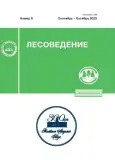Aphid Species Composition in Three Parks of Saint-Petersburg and Leningrad Region in 2021
- Authors: Berim M.N.1
-
Affiliations:
- All-Russian Institute of Plant Protection, Laboratory of Phytosanitary Diagnostics and Forecasts
- Issue: No 5 (2023)
- Pages: 543-548
- Section: SHORT COMMUNICATION
- URL: https://journals.rcsi.science/0024-1148/article/view/140487
- DOI: https://doi.org/10.31857/S0024114823050029
- EDN: https://elibrary.ru/NZMJII
- ID: 140487
Cite item
Full Text
Abstract
Due to the high harmfulness of aphids inhabiting trees and shrubs in the St. Petersburg’s and the Leningrad Region’s park areas, it becomes necessary to monitor the dynamics of the numbers and species composition of this group of insects. During the vegetation season of 2021, the species composition of aphids was determined in three parks in St. Petersburg and the Leningrad Region: Sosnovsky forest park, Pavlovsky and Gatchina parks. The material was taken directly from plants and caught using an entomological net. A total of 16 species were identified. In the Sosnovsky forest park, 10 species were identified, in the Pavlovsky park – 12, in the Gatchinsky park – 9 species. Two species were found on coniferous trees, the rest – on the deciduous ones. Species such as dogwood aphid (Anoecia corni F.), bird cherry-oat aphid (Rhopalosiphum padi L.), silver birch aphid (E-uceraphis betulae gr. sp.), common oak aphid (Tuberculatus annulatus Hart.), black bean aphid (Aphis fabae Scop.), rose aphid (Macrosiphum rosae L.) were found in all three parks, the rest – in one or two parks. Dogwood aphid, bird cherry-oat aphid, silver birch aphid, black bean aphid and rose aphid were observed in massively large colonies on a significant number of host trees. In other species, small colonies were found on separate trees; finally, for some species only single individuals were caught. In the first half of September, the number of aphids was relatively low.
About the authors
M. N. Berim
All-Russian Institute of Plant Protection, Laboratory of Phytosanitary Diagnostics and Forecasts
Author for correspondence.
Email: berim_m@mail.ru
Russia, 196608, St. Petersburg – Pushkin, Podbelskogo hwy, 3
References
- Бей-Биенко Г.Я. Определитель насекомых Европейской части СССР. Том 1. М.–Л.: Наука, 1964. 489–616 с.
- Берим М.Н. Дистанционный мониторинг тлей с помощью всасывающей ловушки // Современные технологии и средства защиты растений – платформа для инновационного освоения в АПК России: Материалы конференции. СПб, Пушкин: ВИЗР, 2018. С. 28–29.
- Берим М.Н. Влияние погодных условий на численность черемухово-злаковой тли Rhopalosiphum padi L. на Северо-Западе России // Известия Оренбургского государственного аграрного университета. 2019. № 6 (80). С. 109–111.
- Верещагина А.Б., Гандрабур Е.С. Особенности развития клонов черемухово-злаковой тли Rhopalosiphum padi (L.) (Homoptera, Aphididae) при гетероцийном образе жизни // XV съезд Русского энтомологического общества: Материалы съезда. Новосибирск: Грамонд. 2017. С. 104–105.
- Новгородова Т.А. Долевой вклад членов многовидовой ассоциации муравьев в потенциал численности общих симбиотов – тлей. // Доклады Академии наук. 2005. Т. 401. № 6. С. 848–849.
- Островский А.М. Первые результаты изучения облигатных мирмекофильных тлей (Hemiptera: Sternorrhyncha: Aphididae) юга-востока Беларуси // Трансформация экосистем. 2021. Т. 4. № 2 (12). С. 103–110.
- Погода и климат [Электронный ресурс]. http: //pogodaklimat.ru> Saint-Petersburg> 2021 (дата обращения – 13.07.2022).
- Рупайс А.А. Вредители деревьев и кустарников в зеленых насаждениях Латвийской ССР. Рига: Зинатне, 1981. 264 с.
- Рупайс А.А. Атлас дендрофильных тлей Прибалтики. Рига: Зинатне, 1969.361 с.
- Развязкина Г.М. Вирусные болезни зерновых. Новосибирск: Наука, 1975. 292 с.
- Сухов К.С., Развязкина Г.М. Биология вирусов и вирусных болезней. М.: Советская наука, 1955. 228 с.
- Тарр С. Основы патологии растений. М.: Мир, 1975. 587 с.
- Цыпленков А.Е., Берим М.Н., Жарова Е.А. Особенности проявления эпифитотий вируса желтой карликовости ячменя // Вестник защиты растений. 2002. № 3. С. 60–64.
- Blackman R.L., Eastop V.F. Aphids on the World’s herbaceous plants and shrubs. 2006. V. 1: Host lists and keys. London: Natural history museum. 1438 p. Freely available at: http: //www.aphidsonworldsplants (retrieval elate: 25.10.2021).
- Gandrabur E.S., Vereshchagina A.B. Formation of the number of Rhopalosiphum padi (L.) (Homoptera, Aphidoidea) when feeding on two genotypes of its primary host under the influence of different climate conditions in a North-West Russia // Proc. XVIII Int. Plant Protection Cong. (Berlin, 24–28 aug. 2015). Berlin, 2015. P. 710–711.
- Dixon A.F.G. Aphid ecology. 2nd edn. London, UK: Chapman and Hall, 1998. 300 p.
- Williams J.S., Dixon A.F. Life cycles and polymorphism // Aphid as crop pests. Ed. H.F.van Emden and R. Harrington. CABI, 2007. 717 p.
Supplementary files









